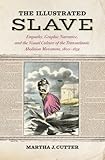The illustrated slave : empathy, graphic narrative, and the visual culture of the transatlantic abolition movement, 1800-1852 / Martha J. Cutter.
Material type: TextPublication details: Athens, Georgia : The University of Georgia Press, (c)2017.Description: 1 online resourceContent type:
TextPublication details: Athens, Georgia : The University of Georgia Press, (c)2017.Description: 1 online resourceContent type: - text
- computer
- online resource
- 9780820351155
- PS217 .I458 2017
- COPYRIGHT NOT covered - Click this link to request copyright permission: https://lib.ciu.edu/copyright-request-form
| Item type | Current library | Collection | Call number | URL | Status | Date due | Barcode | |
|---|---|---|---|---|---|---|---|---|
 Online Book (LOGIN USING YOUR MY CIU LOGIN AND PASSWORD)
Online Book (LOGIN USING YOUR MY CIU LOGIN AND PASSWORD)
|
G. Allen Fleece Library ONLINE | Non-fiction | PS217.55 (Browse shelf(Opens below)) | Link to resource | Available | on1000521551 |
Browsing G. Allen Fleece Library shelves, Shelving location: ONLINE, Collection: Non-fiction Close shelf browser (Hides shelf browser)
Includes bibliographies and index.
Visualizing slavery and slave torture -- Precursors: picturing the story of slavery in broadsides, pamphlets, and early illustrated graphic works about slavery, 1793-1812 -- "These loathsome pictures shall be published": reconfigurations of the optical regime of transatlantic slavery in Amelia Opie's The black man's lament (1826) and George Bourne's Picture of slavery in the United States of America (1834) -- Entering and exiting the sensorium of slave torture: a narrative of the adventures and escape of Moses Roper, from American slavery (1837, 1838) and the visual culture of the slave's body in the transatlantic abolition movement -- Structuring a new abolitionist reading of masculinity and femininity: the graphic narrative systems of Lydia Maria Child's Joanna (1838) and Henry Bibb's Narrative of the life and adventures of Henry Bibb, an American slave, written by himself (1849) -- After Tom: illustrated books, panoramas, and the staging of the African American enslaved body in Uncle Tom's cabin (1852) and the performance work of Henry Box Brown (1849-1875) -- The end of empathy, or slavery revisited via twentieth- and twenty-first-century artworks -- Hierarchical and parallel empathy.
" ... Analyzes ... works in the archive of antislavery illustrated books published from 1800 to 1852 alongside other visual materials that depict enslavement"--
COPYRIGHT NOT covered - Click this link to request copyright permission:
There are no comments on this title.







